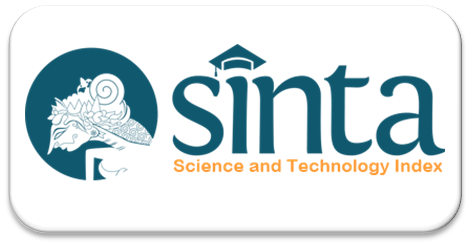Hubungan Tindakan Mandiri Personal Hygiene Oleh Perawat Dengan Tingkat Kepuasan Pasien Imobilisasi Di Ruang Rawat Inap Rsud Dr. R Goetheng Taroenadibrata Purbalingga
Abstract
Patient immobilization has a very large dependence on the needs of nurses
cared for themselves. Therefore, nurses in providing personal hygiene measures should be done as fully as possible in accordance with standard operating procedures issued by the hospital in order to satisfy the patient.
Objective of studies to determine the relationship of independent action of personal hygiene by nurses with a satisfaction levels of immobilization patient in the inpatient room of RSUD dr. R Goetheng Taroenadibrata Purbalingga.
The Type of study used correlational analysis studies with cross sectional approach. Samples of studied were the immobilization patient's in the inpatient room of RSUD dr. R Goetheng Taroenadibrata Purbalingga as much as 69 people. Data was collected used a questionnaire. Analysis data of research used chi square test.
The act independently of personal hygiene by the majority of nurses in the independent category were 63 men (91,3%). The satisfaction levels of Immobilization patient in the inpatient room the majority in the satisfied category as many as 64 people (92,8%). Statistical test results obtained by the x2 = 17.871 with p-value = 0.000 which is less than a = 0.05, it mean there was an independent act of personal hygiene by nurses with immobilization levels of patient satisfaction in inpatient hospitals room dr. R Goetheng Taroenadibrata
Purbalingga of 2012
Key Words : personal hygiene, nursing, levels of satisfaction
References
Arikunto. 2002. Prosedur Penelitian Suatu Pendekatan Praktik. Jakarta: Rineka Cipta.
Asmadi. 2008. Prosedural Keperawatan: Konsep Dan Aplikasi Kebutuhan Dasar Klien. Jakarta: Salemba Medika.
Azwar, S. 1997. Pengantar Administrasi Kesehatan Edisi kedua. Jakarta: PT. Binarupa Aksara. Damayanti. 2010. Efektifitas Tindakan Personal Hygiene Terhadap Tingkat Kepuasan Pasien Imobilisasi Di RS Mardi Rahayu Kudus. Skripsi. Semarang: Universitas Diponegoro.
Hamid, A.Y. 2000. Konsep Perawat Ideal Dalam Pengetahuan, Keterampilan, Etik Dan Etiket Profesional. Makalah disampaikan pada Seminar Sehari Keperawatan RSUD Banyumas. Hidayat, A. 2004. Metode Penelitian Keperawatan dan Teknik Analisis Data. Jakarta: Salemba.
Hidayat. 2003. Pengantar Kebutuhan Dasar Manusia. Aplikasi Konsep Dan Proses Keperawatan. Jakarta: Salemba Medika.
Kotler, P. 2000. Manajemen Pemasaran : Analisis, Perencanaan, Implementasi dan Pengendalian. Jakarta: Erlangga.
Kurniyanta P. 2008. Keputihan Tidak Normal. http://www.balipost.co.id/balipostcetak/2002/10/ 6/kes1.html. Diakses tanggal 10 Januari 2012.
Lupiyoadi, Rambat. 2001. Manajemen Pemasaran Jasa: Teori dan Praktik. Jakarta: Salemba Empat.
Nasution. 2009. Analisa Tingkat Kepuasan Pasien Pada Pelayanan Keperawatan Prima di Ruang rawat Inap Rumah Sakit Umum Pusat Haji Adam Malik Medan.
Sugiyono. 2006. Statistika Untuk Penelitian. Bandung: Alfabeta.
Sugiyono. 2007. Metodelogi Penelitian Kuantitatif, Kualitatif dan R&D. Bandung: Alfabeta. Tarwoto dan Wartonah. 2004. Kebutuhan Dasar Manusia Dan Proses Keperawatan. Jakarta: Salemba Medika.
Downloads
Published
How to Cite
Issue
Section
License
Submitted paper will be firstly reviewed by the editors to determine whether the paper meet the edition theme and submission guidelines. Papers which meet the theme and the guidelines will be assigned to selected reviewers for peer-reviews. Viva Medika: Jurnal Kesehatan, Kebidanan dan Keperawatan is a double blind peer-reviewed journal which involves reviewers based on their experties relevant to the topic of the paper. Final decision of paper acceptance is solely decided by the editors according to reviewers' comment.
Plagiarism and self-plagiarism are prohibited. Viva Medika: Jurnal Kesehatan, Kebidanan dan Keperawatan uses PlagiarismCheckerX and iThenticate to scan papers for detecting plagiarism. Thus, Appropriate citation and quotation should be used

.png)








